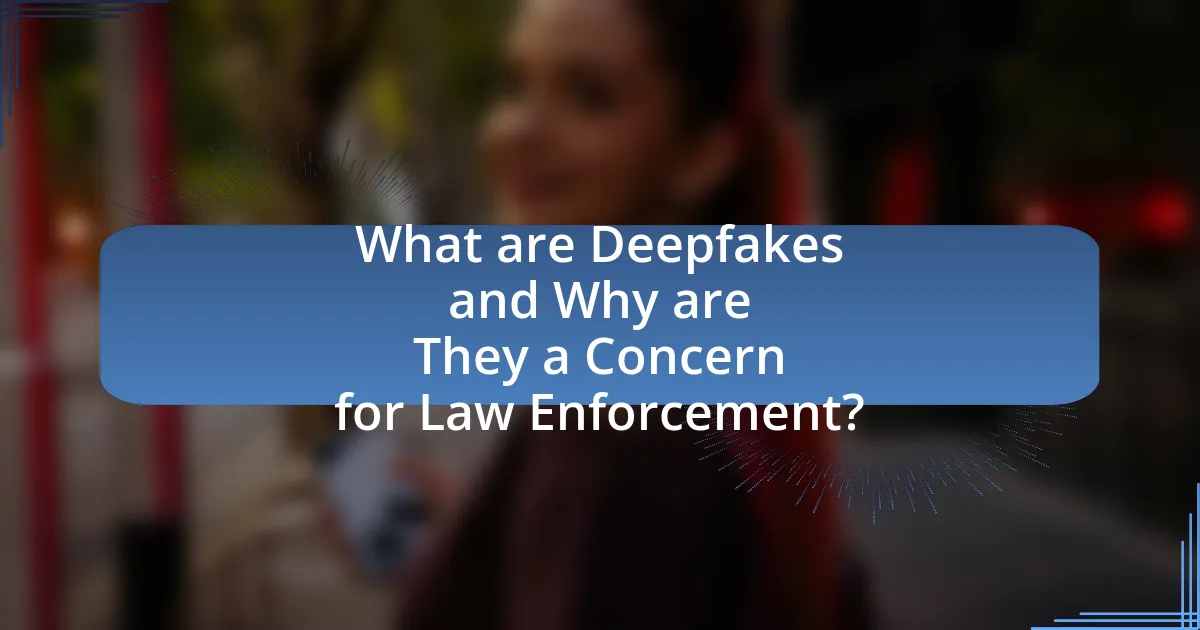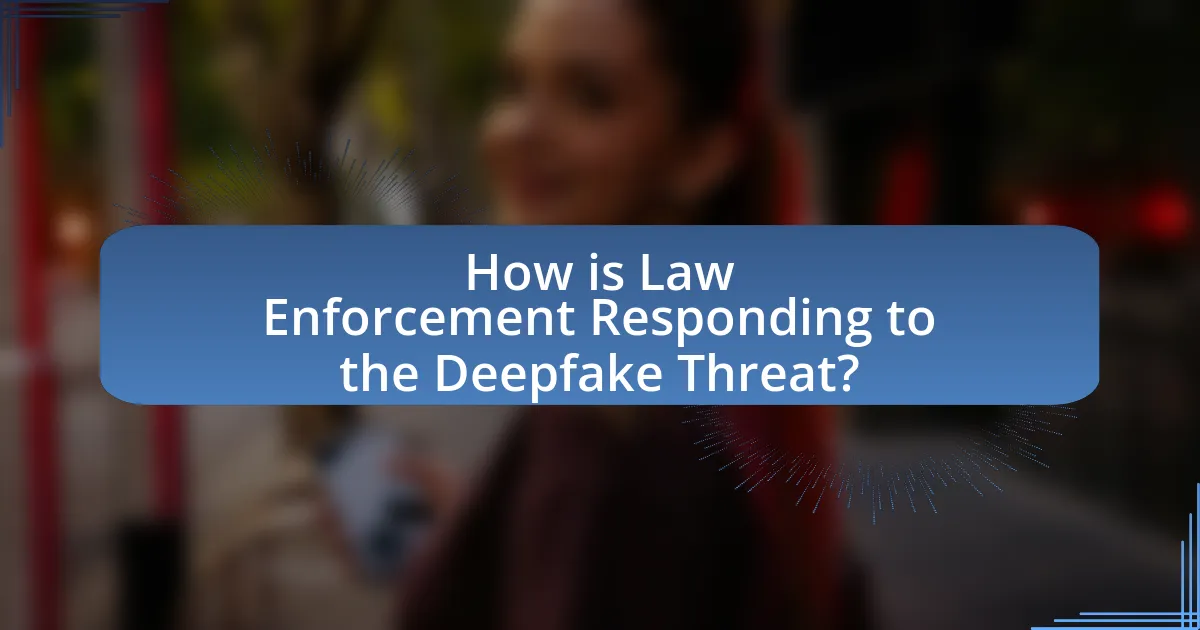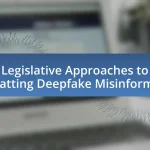Deepfakes are synthetic media generated through artificial intelligence that can manipulate audio and video, raising significant concerns for law enforcement due to their potential for creating misleading evidence, facilitating fraud, and eroding public trust in media. This article examines how law enforcement agencies are responding to the challenges posed by deepfakes, including the development of specialized training programs, collaboration with technology companies for detection tools, and the implementation of advanced detection technologies. It also discusses the legal implications, risks associated with deepfakes, and the importance of public awareness and community engagement in combating misinformation.

What are Deepfakes and Why are They a Concern for Law Enforcement?
Deepfakes are synthetic media created using artificial intelligence that can manipulate audio and video to produce realistic but fabricated content. They pose significant concerns for law enforcement because they can be used to create misleading evidence, facilitate fraud, and undermine trust in legitimate media. For instance, a study by the University of California, Berkeley, found that deepfake technology can generate highly convincing fake videos, which can be exploited for malicious purposes, such as disinformation campaigns or identity theft. This capability challenges law enforcement agencies to verify the authenticity of evidence and maintain public trust in media integrity.
How do deepfakes work and what technologies are involved?
Deepfakes work by using artificial intelligence, particularly deep learning techniques, to create realistic but fabricated audio and visual content. The primary technologies involved include Generative Adversarial Networks (GANs), which consist of two neural networks: a generator that creates fake content and a discriminator that evaluates its authenticity. This adversarial process continues until the generator produces content indistinguishable from real data. Additionally, techniques such as autoencoders and facial recognition algorithms are often employed to enhance the quality and accuracy of the deepfake. The effectiveness of deepfakes has been demonstrated in various studies, highlighting their potential for misuse in misinformation and identity theft, which poses significant challenges for law enforcement agencies.
What are the key components of deepfake technology?
The key components of deepfake technology are generative adversarial networks (GANs), large datasets, and advanced machine learning algorithms. GANs consist of two neural networks, a generator and a discriminator, that work together to create realistic synthetic media by learning from existing images and videos. Large datasets provide the necessary training material for these networks, enabling them to understand and replicate facial features, expressions, and movements accurately. Advanced machine learning algorithms enhance the quality and realism of the generated content, allowing for seamless integration into existing media. These components collectively enable the creation of deepfakes that can be difficult to distinguish from authentic media.
How do these components contribute to the creation of deepfakes?
The components that contribute to the creation of deepfakes include artificial intelligence algorithms, particularly generative adversarial networks (GANs), and extensive datasets of images and videos. AI algorithms, such as GANs, enable the synthesis of realistic images by having two neural networks compete against each other, which enhances the quality of the generated content. Extensive datasets provide the necessary training material, allowing these algorithms to learn and replicate facial features, expressions, and movements accurately. Research indicates that GANs can produce highly convincing deepfakes, as demonstrated in studies like “Deepfakes: A New Threat to Privacy” by K. Z. K. et al., which highlights the effectiveness of these technologies in creating deceptive media.
What are the potential risks associated with deepfakes?
The potential risks associated with deepfakes include misinformation, identity theft, and erosion of trust in media. Misinformation can lead to the spread of false narratives, as deepfakes can convincingly alter reality, influencing public opinion and political outcomes. Identity theft occurs when individuals’ likenesses are manipulated to create fraudulent content, potentially damaging reputations and leading to financial loss. Furthermore, the erosion of trust in media is significant; as deepfakes become more prevalent, audiences may struggle to discern authentic content from fabricated material, undermining the credibility of legitimate news sources. These risks highlight the urgent need for law enforcement to develop strategies to combat the challenges posed by deepfakes.
How can deepfakes impact public trust and safety?
Deepfakes can significantly undermine public trust and safety by spreading misinformation and creating false narratives. The ability to manipulate video and audio content makes it easier for malicious actors to fabricate events or statements, leading to confusion and distrust among the public. For instance, a study by the University of California, Berkeley, found that deepfake technology can erode trust in media sources, as 85% of participants expressed concern about the authenticity of video content. This erosion of trust can have serious implications for societal stability, as individuals may become skeptical of legitimate news and information, potentially leading to increased polarization and unrest.
What legal implications arise from the use of deepfakes?
The legal implications arising from the use of deepfakes include potential violations of privacy rights, defamation laws, and intellectual property rights. Deepfakes can be used to create misleading or harmful content that misrepresents individuals, leading to reputational damage and legal action under defamation statutes. Additionally, the unauthorized use of someone’s likeness in deepfake videos may infringe on their right of publicity, which protects individuals from commercial exploitation of their identity. Furthermore, deepfakes can also violate copyright laws if they incorporate protected content without permission. These legal frameworks are increasingly being scrutinized as the technology evolves, prompting lawmakers to consider new regulations specifically addressing the challenges posed by deepfakes.

How is Law Enforcement Responding to the Deepfake Threat?
Law enforcement is responding to the deepfake threat by developing specialized training programs and collaborating with technology companies to enhance detection capabilities. Agencies like the FBI and the Department of Homeland Security have initiated training sessions focused on identifying deepfake technology and its implications for criminal activities, such as fraud and misinformation. Additionally, partnerships with tech firms aim to create advanced tools that can analyze and detect manipulated media, thereby improving the ability to combat the misuse of deepfakes in real-time scenarios.
What strategies are law enforcement agencies implementing to combat deepfakes?
Law enforcement agencies are implementing a range of strategies to combat deepfakes, including the development of advanced detection technologies and collaboration with tech companies. These agencies are investing in artificial intelligence tools that can analyze video and audio content for signs of manipulation, enhancing their ability to identify deepfakes quickly. For instance, the FBI has been actively researching and deploying machine learning algorithms that can detect inconsistencies in facial movements and audio synchronization, which are common indicators of deepfake content. Additionally, law enforcement is forming partnerships with technology firms to share knowledge and resources, thereby improving their overall response to the challenges posed by deepfakes.
How are training programs evolving to include deepfake detection?
Training programs are evolving to include deepfake detection by integrating advanced technologies and methodologies that enhance the skills of law enforcement personnel. These programs now incorporate machine learning algorithms and artificial intelligence tools specifically designed to identify manipulated media, reflecting the growing sophistication of deepfake technology. For instance, the FBI has developed training modules that focus on recognizing signs of digital manipulation, which are essential for investigators in the field. Additionally, partnerships with tech companies and academic institutions are being established to provide ongoing education and resources, ensuring that law enforcement stays updated on the latest deepfake detection techniques and trends.
What partnerships are being formed to enhance deepfake response capabilities?
Partnerships are being formed between law enforcement agencies, technology companies, and academic institutions to enhance deepfake response capabilities. For instance, the FBI has collaborated with tech firms like Microsoft and Google to develop tools that can detect deepfakes, while universities are conducting research to improve detection algorithms. These collaborations aim to leverage technological advancements and expertise to combat the growing threat of deepfakes effectively.
What tools and technologies are being developed for deepfake detection?
Tools and technologies being developed for deepfake detection include machine learning algorithms, blockchain technology, and digital forensics tools. Machine learning algorithms analyze video and audio data to identify inconsistencies and artifacts typical of deepfakes, such as unnatural facial movements or audio mismatches. Blockchain technology is being explored for its potential to verify the authenticity of media by creating immutable records of original content. Digital forensics tools are also evolving to include features that can detect manipulation in images and videos, providing law enforcement with reliable methods to assess the integrity of digital evidence. These advancements are crucial as deepfake technology becomes more sophisticated, necessitating robust detection methods to combat misinformation and fraud.
How effective are current detection tools in identifying deepfakes?
Current detection tools are moderately effective in identifying deepfakes, with accuracy rates varying significantly based on the technology used and the sophistication of the deepfake itself. Research indicates that some detection algorithms can achieve over 90% accuracy in identifying manipulated videos, particularly when trained on large datasets of known deepfakes. However, as deepfake technology evolves, detection tools often struggle to keep pace, leading to a cat-and-mouse dynamic between creators and detectors. For instance, a study by the University of California, Berkeley, published in 2020, demonstrated that while certain models could effectively detect deepfakes, they were less reliable against newer, more advanced versions that employed techniques like generative adversarial networks (GANs). This highlights the ongoing challenge law enforcement faces in adapting to the rapid advancements in deepfake technology.
What advancements are being made in AI and machine learning for detection?
Advancements in AI and machine learning for detection include the development of sophisticated algorithms that can identify deepfake content with high accuracy. For instance, researchers have created deep learning models that analyze facial movements and audio-visual inconsistencies, achieving detection rates exceeding 90% in controlled environments. Additionally, tools like Microsoft’s Video Authenticator and Facebook’s Deepfake Detection Challenge have contributed to enhancing detection capabilities by providing datasets and benchmarks for training AI systems. These advancements are crucial for law enforcement agencies as they combat the rising threat of deepfakes in misinformation and fraud.

What Challenges Do Law Enforcement Agencies Face in Addressing Deepfakes?
Law enforcement agencies face significant challenges in addressing deepfakes, primarily due to the rapid advancement of technology that makes detection increasingly difficult. The sophistication of deepfake algorithms allows for highly realistic manipulations of audio and video, complicating the verification of evidence. Additionally, the anonymity provided by the internet enables malicious actors to create and distribute deepfakes without accountability, making it hard for law enforcement to trace the origins of such content. Furthermore, existing legal frameworks often lag behind technological developments, hindering effective prosecution and regulation of deepfake-related crimes. These challenges are compounded by the need for specialized training and resources to keep pace with evolving deepfake technologies, which many agencies may lack.
What are the limitations of current deepfake detection methods?
Current deepfake detection methods face significant limitations, primarily due to their reliance on specific algorithms that may not generalize well across different types of deepfakes. These methods often struggle with detecting high-quality deepfakes that closely mimic real human behavior, as they can be trained on limited datasets that do not encompass the vast variability in deepfake generation techniques. Additionally, many detection systems are vulnerable to adversarial attacks, where slight modifications to the deepfake can evade detection. Research indicates that as deepfake technology evolves, detection methods must continuously adapt, yet many existing systems lack the necessary flexibility and robustness to keep pace with these advancements.
How do evolving deepfake technologies outpace detection efforts?
Evolving deepfake technologies outpace detection efforts primarily due to their rapid advancements in artificial intelligence and machine learning techniques. These technologies continuously improve in generating realistic audio and visual content, making it increasingly difficult for existing detection algorithms to identify manipulated media. For instance, deepfake creation tools have become more accessible and user-friendly, allowing even non-experts to produce high-quality fakes. As a result, detection systems struggle to keep up with the sophistication of these deepfakes, which often employ techniques like generative adversarial networks (GANs) that can produce highly convincing results. Studies indicate that while detection methods are evolving, they often lag behind the innovations in deepfake creation, leading to a growing gap in effectiveness.
What resource constraints do law enforcement agencies encounter?
Law enforcement agencies encounter significant resource constraints, including limited funding, insufficient personnel, and inadequate technological infrastructure. These constraints hinder their ability to effectively combat emerging threats such as deepfakes. For instance, a report from the Police Executive Research Forum indicates that many agencies operate on tight budgets, which restricts their capacity to invest in advanced training and tools necessary for identifying and addressing deepfake-related crimes. Additionally, a survey by the International Association of Chiefs of Police found that 70% of agencies reported staffing shortages, impacting their operational effectiveness.
How can law enforcement improve public awareness about deepfakes?
Law enforcement can improve public awareness about deepfakes by implementing educational campaigns that inform the public about the technology, its potential misuse, and how to identify deepfakes. These campaigns can include workshops, online resources, and partnerships with community organizations to disseminate information effectively. For instance, the FBI has previously launched initiatives to educate citizens on misinformation and digital literacy, highlighting the importance of recognizing manipulated media. By providing clear examples and practical tools, law enforcement can empower individuals to critically assess the authenticity of digital content, thereby reducing the impact of deepfakes on society.
What role does community engagement play in combating deepfake misinformation?
Community engagement plays a crucial role in combating deepfake misinformation by fostering awareness and promoting critical thinking among individuals. Engaged communities can share knowledge about the existence and implications of deepfakes, enabling members to recognize and question potentially misleading content. Research indicates that educational initiatives, such as workshops and online campaigns, significantly enhance public understanding of digital media literacy, which is essential for identifying deepfake technology. For instance, a study by the Pew Research Center found that 86% of Americans believe that misinformation is a major problem, highlighting the need for community-driven efforts to address this issue effectively. By actively participating in discussions and sharing resources, communities can collectively mitigate the impact of deepfake misinformation and support law enforcement in their efforts to tackle this evolving challenge.
How can educational initiatives help mitigate the impact of deepfakes?
Educational initiatives can mitigate the impact of deepfakes by increasing public awareness and enhancing critical media literacy skills. By educating individuals about the existence and characteristics of deepfakes, these initiatives empower people to recognize manipulated content, reducing the likelihood of misinformation spread. Research indicates that media literacy programs can significantly improve individuals’ ability to discern credible information from deceptive content, as evidenced by a study published in the Journal of Media Literacy Education, which found that participants in such programs demonstrated a 30% increase in their ability to identify fake news and manipulated media.
What best practices can law enforcement adopt to effectively tackle deepfake challenges?
Law enforcement can adopt several best practices to effectively tackle deepfake challenges, including the implementation of advanced detection technologies, training personnel on deepfake identification, and fostering collaboration with technology companies and academic institutions. Advanced detection technologies, such as machine learning algorithms specifically designed to identify manipulated media, can significantly enhance the ability to recognize deepfakes. Training programs for law enforcement personnel can improve their skills in recognizing the signs of deepfakes, which is crucial given the rapid evolution of this technology. Collaboration with technology companies and academic institutions can facilitate the sharing of knowledge and resources, leading to the development of more effective detection tools and strategies. These practices are supported by the increasing prevalence of deepfakes in criminal activities, highlighting the urgent need for law enforcement to adapt and respond effectively.


